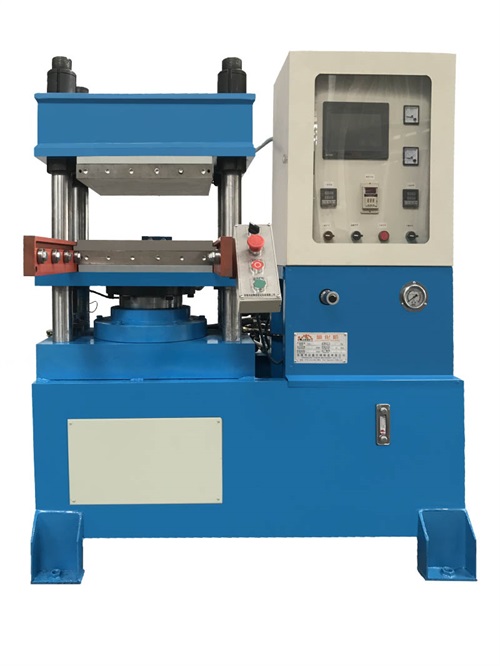
Vulcanization equipment is machinery used in the process of vulcanization, which is a chemical process.The vulcanization process typically involves heating the rubber material along with the curatives, such as sulfur, accelerators, and activators. Vulcanization equipment plays a crucial role in controlling and facilitating this process. There are various types of vulcanization equipment, each designed to cater to different scales of production and types of rubber products.
Model | YX-DJ63T-1 |
Hot plate specification | 400*400mm |
Hot plate spacing | 200mm |
Cylinder diameter | 200mm |
Machine structure | Four column/single head/double head model |
System pressure | 18MPa |
Heating system | Imported electric heating tube |
Power supply specification | 380V/50HZ |

Essential details | |||
Place of Origin | China | Applicable Industries | Hotels, Machinery Repair Shops, Home Use |
Type | Showroom Location | None | |
Condition | New | Model | YX-DJ63T-1 |
Video outgoing-inspection | Provided | Hot plate specification | 400*400mm |
Machinery Test Report | Provided | Hot plate spacing | 200mm |
Warranty of core components | 1 Year | Cylinder diameter | 200mm |
Core Components | PLC | Motor power | 4KW |
Voltage | 300V/50HZ | Temperature range | Normal temperature -350°C |
Dimension(L*W*H) | 1.5*1.4*1.5(m) | Working level | Upper and lower layer |
Warranty | 1 Year | Machine structure | Four column/single head/double head model |
Key Selling Points | Automatic | System pressure | 18MPa |
Power (kW) | 4 kW | Power | 380V/50HZ |
Weight (KG) | 1300 KG | ||
Vulcanising Equipment
Features of vulcanising equipment: The structure of the machine body determines the accuracy, life and stability of the machine; the efficient and stable oil pressure design improves the efficiency. The equipment we produce has the following advantages:
1. Beautiful and durable frame: The machine frame adopts UG software and PRO-E3D analysis aided design to achieve high rigidity, precise structure and long life. The tripod is designed with a square steel beam structure to ensure the stability of the machine.
2. High-precision heating plate: The thickened heating plate adopts deep hole processing, and is subjected to carburizing heat treatment, absorbing the principle of heat flow, and the temperature accuracy is high and uniform. The hot plate is processed by computer gong CNC, and the inlet and outlet modules are carburized, and are finished by grinding and nitriding. The wear time is long, it is not easy to deform, and the plane precision is high.
3. Independent dual motors and dual oil pumps: the double-head flat vulcanizing machine series adopts dual motors, dual oil pumps, and dual oil circuit systems, and the dual shafts work completely independently
4. Special oil circuit design: Special oil circuit design, oil circuit has no impact during operation, low noise, good stability, fast entry and exit, rising and falling speeds. Improve efficiency and reduce energy consumption
5. High and low voltage conversion design: specially designed high-speed circuit, so that the slow-speed clamping switch is stable and the speed can be adjusted to adapt to different types of molds
6. Independent exhaust circuit design: The independent exhaust circuit design can adjust the exhaust time and the number of exhaust gas, so that the exhaust accuracy can reach 100%.
Vulcanizing Tools and Equipment List
Vulcanizing tools and equipment list:There are various types of vulcanizing machine, each designed to cater to different scales of production and types of rubber products. The choice of vulcanization equipment depends on factors such as the type of rubber material, the size and shape of the product, production volume, and desired properties of the final product. Manufacturers often tailor their vulcanization equipment to meet specific requirements and optimize the vulcanization process for their particular applications.
1. Autoclaves: These are large, pressure-controlled vessels used for vulcanizing large rubber products like tires. The autoclave provides precise control over temperature, pressure, and curing time to ensure uniform vulcanization.
2. Presses: Presses are used for smaller-scale vulcanization processes. They consist of heated platens that clamp the rubber material under pressure. This equipment is commonly used for making gaskets, seals, and small rubber components.
3. Continuous Vulcanization Lines: These production lines are used for continuous vulcanization of rubber materials. They can include various stages such as preheating, curing, and cooling, and are commonly used for products like conveyor belts.
4. Microwave Vulcanization Systems: Microwave technology has been used to vulcanize rubber materials more rapidly and efficiently. It allows for better control of the vulcanization process and reduces energy consumption compared to traditional methods.